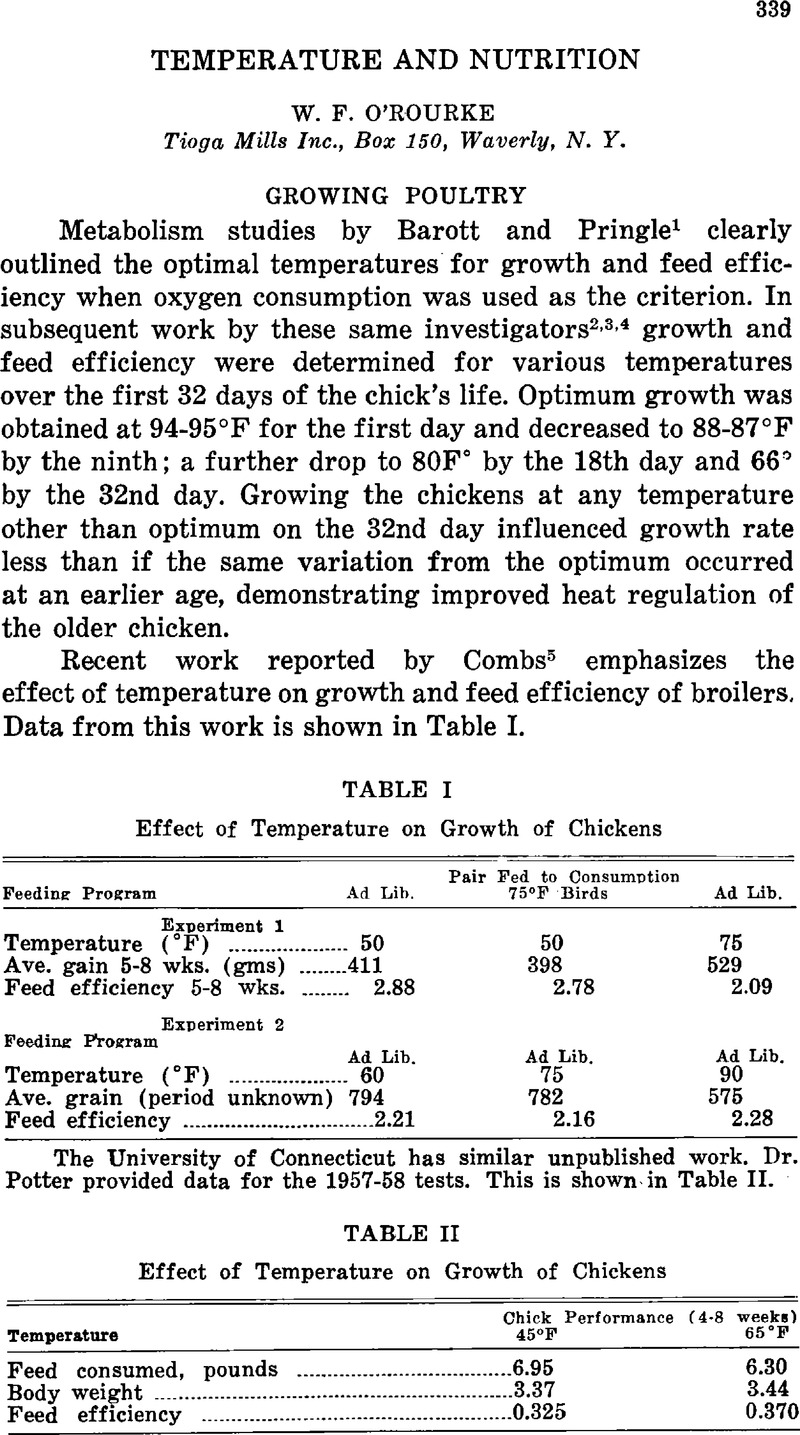No CrossRef data available.
Article contents
Temperature and Nutrition
Published online by Cambridge University Press: 18 September 2007
Abstract
An abstract is not available for this content so a preview has been provided. Please use the Get access link above for information on how to access this content.

- Type
- Research Article
- Information
- Copyright
- Copyright © Cambridge University Press 1960
References
1.Barott, H. G. and Pringle, E. M. 1946. Energy and gaseous metabolism of the chicken from hatch to maturity as effected by temperature. J. Nutrition 31:35.CrossRefGoogle Scholar
2.Barott, H. G. and Pringle, E. M. 1957. Effect of environment on growth and feed and water consumption of chickens. I. The effect of temperature of environment during the first nine days after hatch J. Nutrition 34:53.CrossRefGoogle Scholar
3.Barott, H. G. and Pringle, E. M. 1949. Effect of environment on growth and feed and water consumption of chickens. II. The effect of temperature and humidity of environment during the first 18 days after hatch. J. Nutrition 37:153.CrossRefGoogle Scholar
4.Barott, H. G. and Pringle, E. M. 1950. Effect of environment on growth and feed and water consumption of chickens III. The effect of temperature of environment during the period from 18 to 32 days of age. J. Nutrition 41:25.CrossRefGoogle Scholar
5.Combs, F. G. 1959. Maryland Research–Broiler Nutrition. University of Maryland 1959 Nut. Conf. for Feed Manufacturers.Google Scholar
6.Mills, C. A. 1942. Environmental temperatures and B-vitamin requirements. Arch. Biochem. 1:72.Google Scholar
7.Mills, C. A., Cottingham, E. and Taylor, E. 1947. The influence of environmental temperature on dietary requirements for thiamine pyridoxine, nicotinic acid, folic acid and choline in chicks. Am. J. Physiology 149:376.CrossRefGoogle ScholarPubMed
8.Squibb, R. L., Guyman, M. A. and Scrimshaw, N. S. 1959. Growth and blood constituents of immature New Hampshire fowl exposed to a constant temperature of 99° F for 7 days. Poultry Sci. 38: 220.CrossRefGoogle Scholar
9.Thornton, P. A. 1959. The response of the chicks to ascorbic acid. Abstracts of Papers of the 48th annual Meeting of the Poultry Science Assoc.Google Scholar
10.Dunkelgod, D. E., Gleaves, E. W., Tonkinson, L. V. and Thayer, R. H. 1959. Vitamin studies with poults fed high protein high fat diets. Abstracts of Papers presented at the 48th Annual Meeting of the Poultry Science Assoc.Google Scholar
11.Almquist, H. J. 1953. Feed requirements of turkey as related to time of year. The Grange Co., Modesto, California.Google Scholar
12.Bruins, H. W. 1958. Energy restriction for replacement pullets. Feedstuffs Vol. 20 No. 39: 32.Google Scholar
13.Huston, T. M. 1959. The effect of Serpasil on controlled and naturally occurring thermal stresses on immature domestic fowl. Rutgers University Tranquilizer Conference Proceedings.Google Scholar
14.Huston, T. M., Joiner, W. P. and Carmon, J. L. 1957. Breed differences in egg production of domestic fowl held at high environmental temperatures. Poultry Sci. 36–1247.Google Scholar
15.Squibb, R. L., Wogan, G. N. and Reed, C. H. 1959. Production of White Leghorn hens subjected to high environmental temperatures with wide diurnal fluctuations. Poultry Sci. 38:1182.CrossRefGoogle Scholar
16.Squibb, R. L. 1959. Relation of diurnal temperature and humidity ranges to egg production and feed efficiency of New Hampshire hens. J. Agric. Sci. 52:217.CrossRefGoogle Scholar
17.Weiss, H. S. 1959. The interrelationship of reproductive state and seasonal acclimatization on the hens' resistance to lethal high temperature. Poultry Sci. 38:430.CrossRefGoogle Scholar
18.Greenwood, A. W. 1958. Long term effects of a constant environment. Abstracts of Papers of the 47th Annual Meeting of the Poultry Science Assoc.Google Scholar
19.Hill, F. W., Anderson, D. L. and Dansky, L. M. 1956. Studies of the energy requirements of chickens. 3. The effect of dietary energy level on the rate and gross efficiency of egg production. Poultry Sci. 35:54.CrossRefGoogle Scholar
20.Hill, F. W. 1956. Studies of the energy requirements of chickens. Evidence for a linear relationship between dietary productive energy level and the efficiency of egg production. Poultry Sci. 35:59.CrossRefGoogle Scholar
21.Singsen, E. P., Matterson, L. D., Tlustohowicz, J. and Potter, L. M. 1958. The effect of energy intake and controlled feeding on the performance of broiler type breeding hens. Pro. Semi Annual Meeting Nut. Council AFMA Dec. 1958.Google Scholar
22.Thornton, P. A. and Moreng, R. E. 1958. The effect of ascorbic acid on egg quality factors. Poultry Sci. 37:691.CrossRefGoogle Scholar
23.Thornton, P. A. and Moreng, R. E. 1959. Further evidence on the value of ascorbic acid for maintenance of shell quality in warm environmental temperature. Poultry Sci. 38: 594.CrossRefGoogle Scholar
24.Thornton, P. A. 1959. Additional studies concerning the use of ascorbic acid in the diet of the laying hen. Abstracts of Papers of the 48th Annual Meeting of the Poultry Science Assoc.Google Scholar
25.Peterson, C. F., Sauter, E. A., Weise, A. C., and Lumijarvi, D. J. 1959. Influence of calcium and other nutrients upon shell quality of high producing White Leghorn hens. Abstracts of Papers of the 48th annual meeting of the Poultry Science Assoc.Google Scholar
26.Gilbreath, J. C., Garvin, L. F. and Welch, Q. B. 1959. Effect of orally administered reserpine on egg production and quality. Poultry Sci. 38:535.CrossRefGoogle Scholar
27.Anderson, D. L. and Smyth, J. R. Jr. 1959. Effect of Serpasil on caged layers—thyroid and cholesterol relationships. Conference on the use of the tranquilizing and antihypertensive agent. Serpasil in animal and poultry production.Google Scholar
28.Weiss, H. S. 1959. The protective effect of Serpasil in laying birds against high lethal temperature. Conference on the use of the tranquilizing and antihypertensive agent. Serpasil in animal and poultry production.Google Scholar
29.Burger, R. E. 1959. The protective action of Serpasil in broilers exposed to thermal stress. Conference on the use of the tranquilizing and antihypertensive agent. Serpasil in animal and poultry production.Google Scholar


